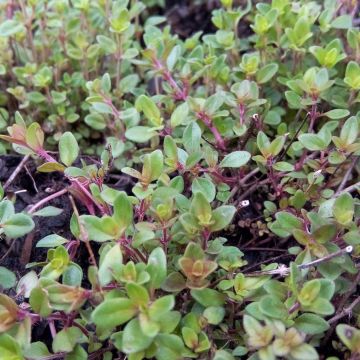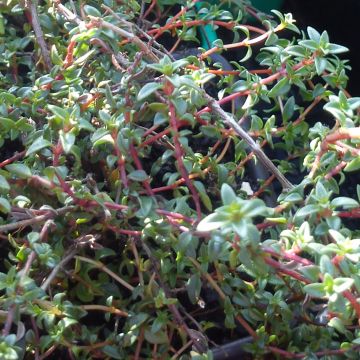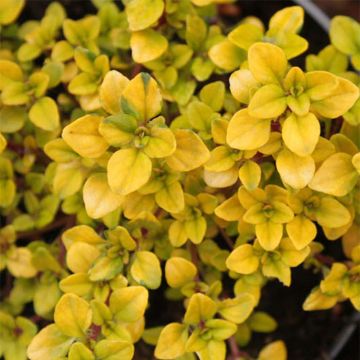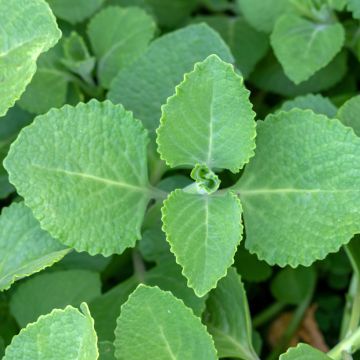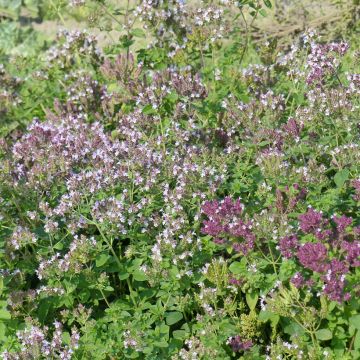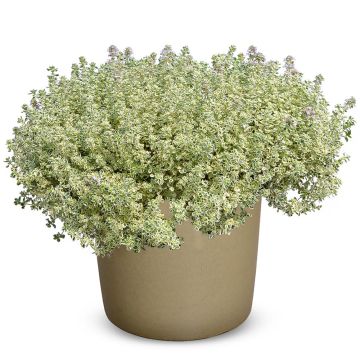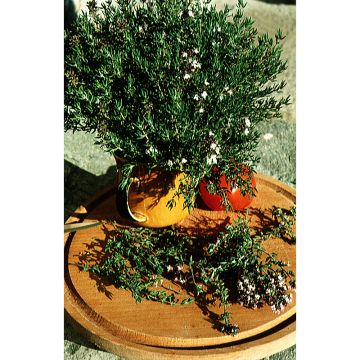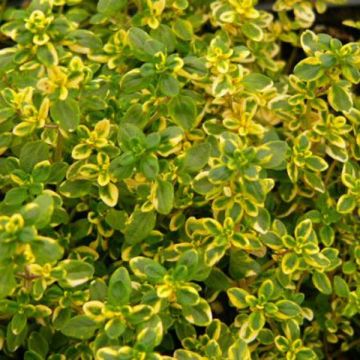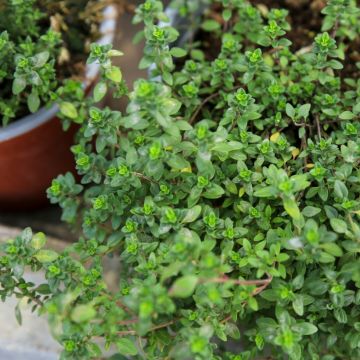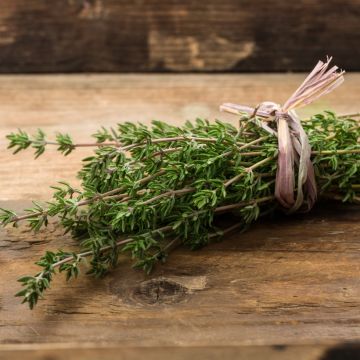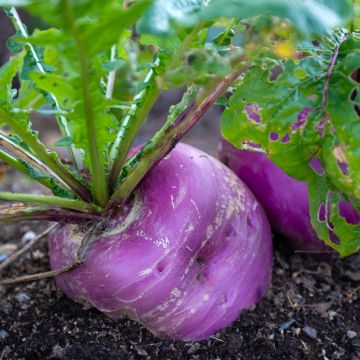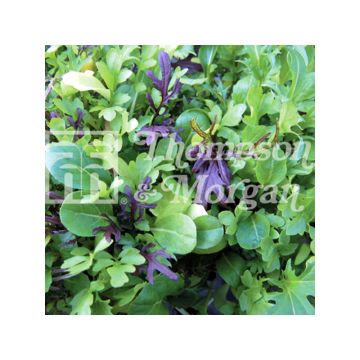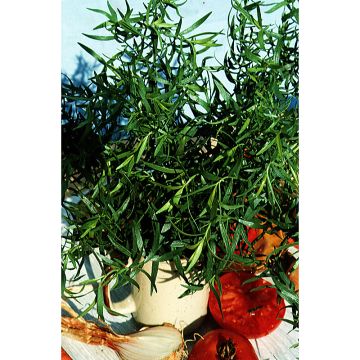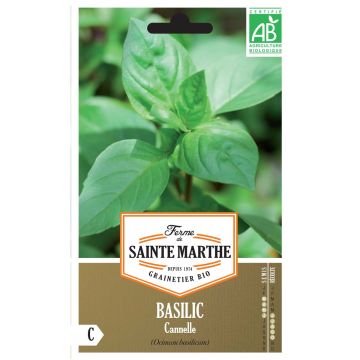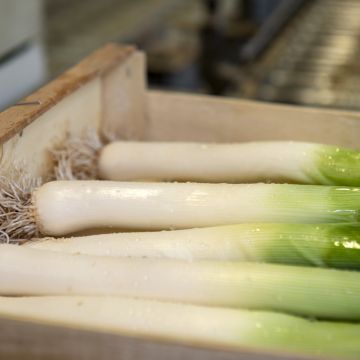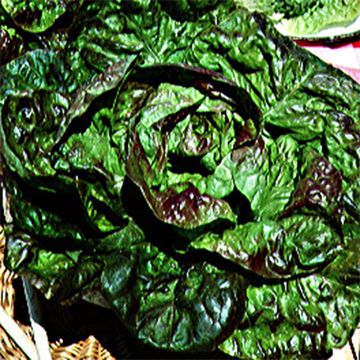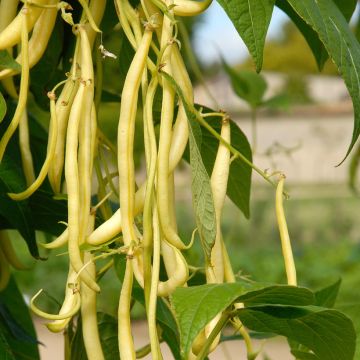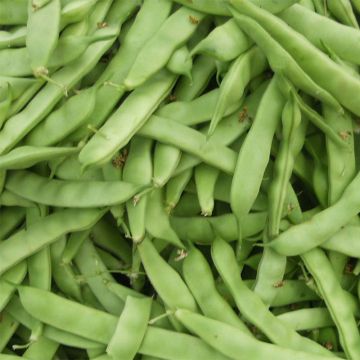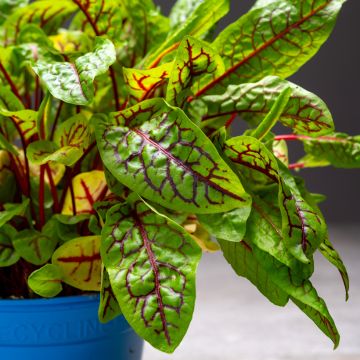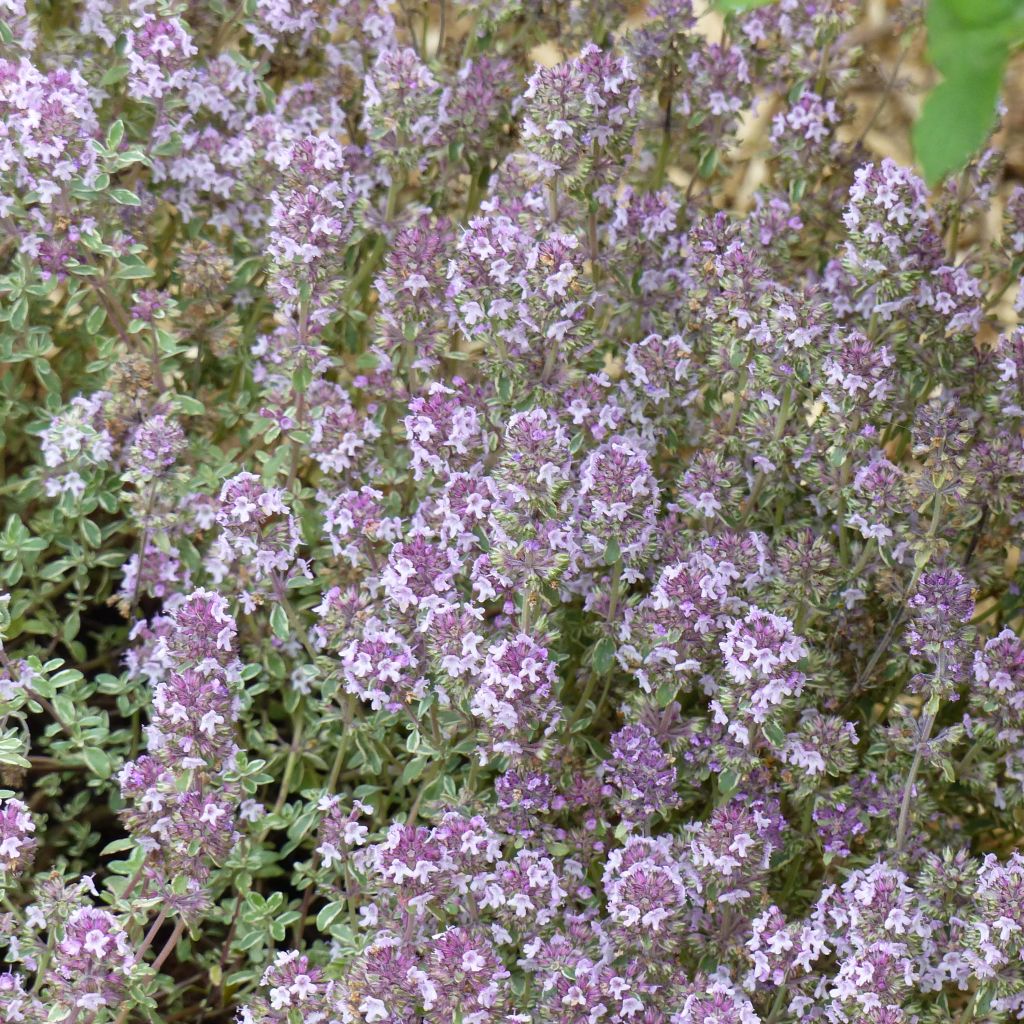

Thymus vulgaris Silver Posie - Silver Thyme
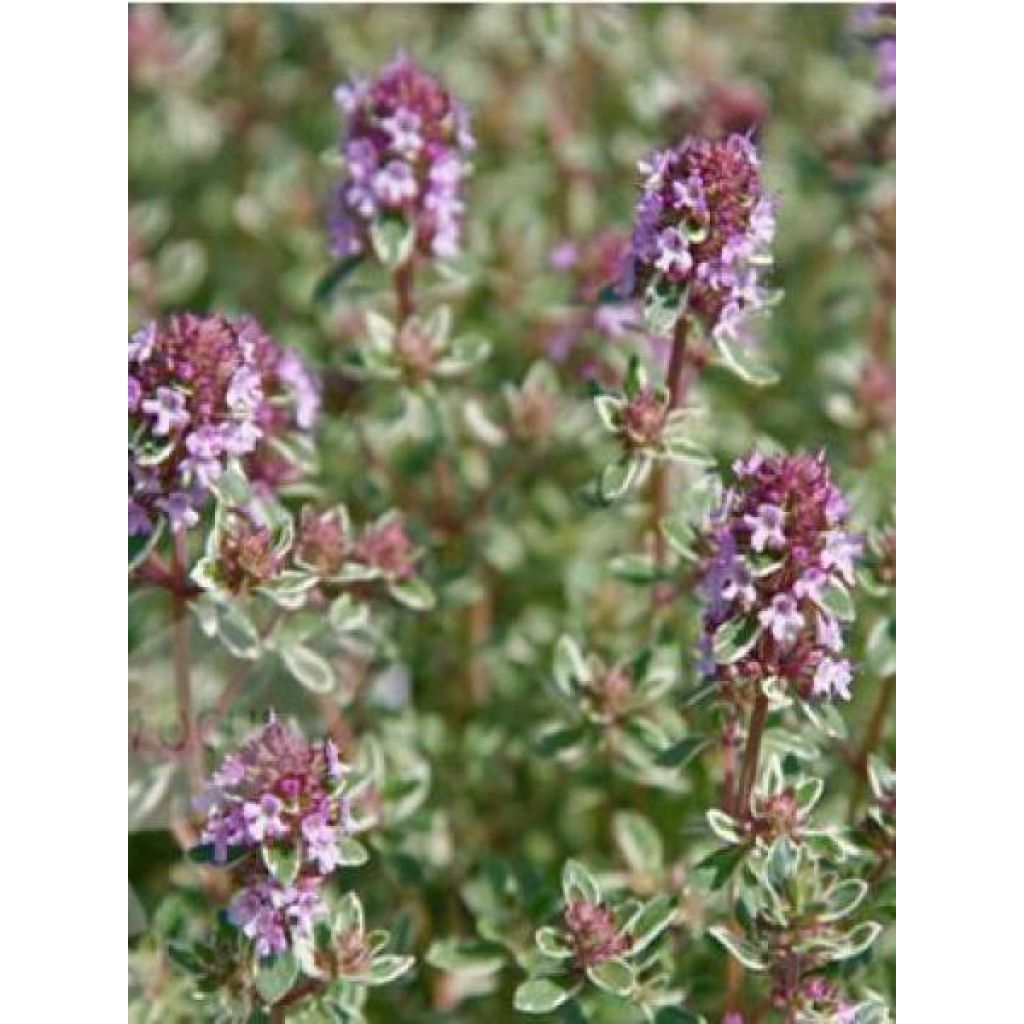

Thymus vulgaris Silver Posie - Silver Thyme
Thymus vulgaris Silver Posie - Silver Thyme
Thymus vulgaris Silver Posie
Common Thyme, Garden Thyme, English Thyme
This item cannot be shipped to the selected country
Delivery charge from €5.90
Delivery charge from €5.90
More information
Schedule delivery date,
and select date in basket
This plant carries a 6 months recovery warranty
More information
We guarantee the quality of our plants for a full growing cycle, and will replace at our expense any plant that fails to recover under normal climatic and planting conditions.
From €5.90 for pickup delivery and €6.90 for home delivery
Express home delivery from €8.90.
From €5.90 for pickup delivery and €6.90 for home delivery
Express home delivery from €8.90.
Description
The Thyme vulgaris 'Silver Posie', also known as Thymus x citriodorus 'Silver Posie', is a creeping variety with beautifully variegated olive green leaves tinged with cream, topped with lilac-pink spikes in June-July. This variety also makes an excellent evergreen ground cover, reaching a height of 10 to 20 cm (4 to 8in). Thyme thrives in most soil types, including rocky soil, but is sensitive to excessive moisture. Plant it in spring or autumn and harvest it all year round.
Native to western and southern Europe, where it is sometimes found in the wild, common Thyme, also known as Farigoule, is a perennial plant belonging to the Lamiaceae family. It forms small fragrant clumps with grey-green foliage that are adorned with pretty little flowers ranging in colour from white to mauve-pink, depending on the variety.
All thyme species are excellent plants for rockeries and paving. They all contain essences that evoke the scent of the Mediterranean scrubland and have properties similar to common thyme.
Common Thyme is a cold and drought-resistant herb that is easy to grow and thrives in poor, light, even rocky and limestone soils that are well-drained. If your soil is rather damp and clayey, we recommend growing it in a pot where it will thrive.
Harvesting: Thyme can be harvested annually as its leaves are evergreen. Preferably pick in the morning. Thyme is most fragrant during its flowering period, in summer. Since it should be pruned to maintain a compact shape, take advantage of this to stock up for the winter months!
Preservation: Thyme is traditionally preserved by drying. After washing and drying the stems, hang the bunches upside down in a dry, well-ventilated place. This is a simple and quick process that you can replace with freezing if you find it more convenient.
Gardener's tip: Don't hesitate to mix different types of plants by placing aromatic herbs like Thyme in the middle of your perennial flower beds or even in rockeries. They will integrate perfectly, and the sometimes powerful aromas of aromatic plants can often repel insects that may attack more delicate plants like roses.
Report an error about the product description
Thymus vulgaris Silver Posie - Silver Thyme in pictures
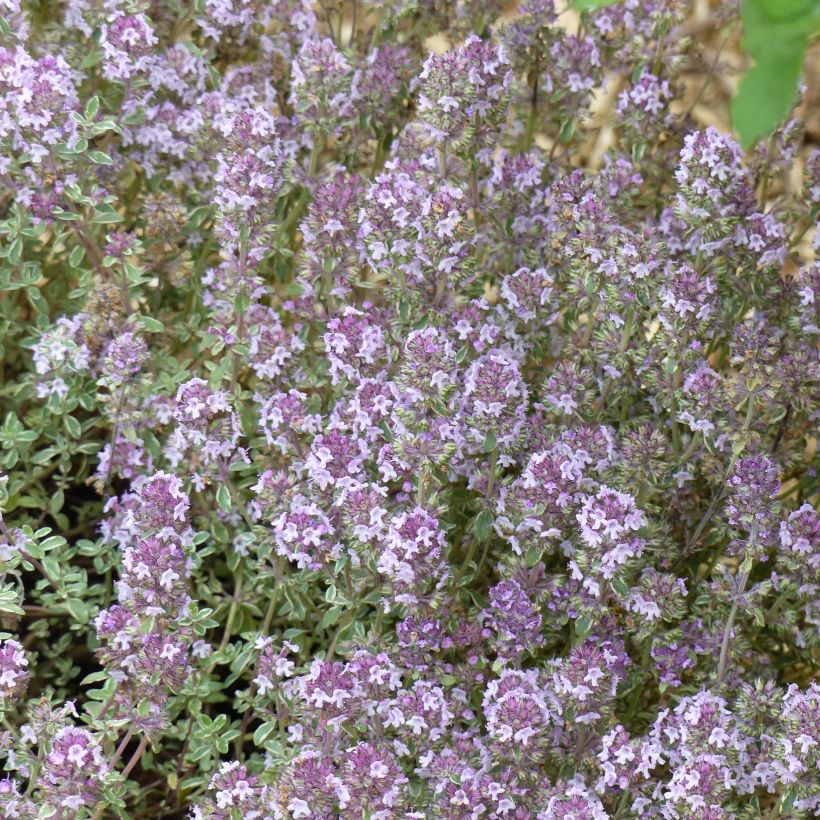

Harvest
Plant habit
Foliage
Botanical data
Thymus
vulgaris
Silver Posie
Lamiaceae
Common Thyme, Garden Thyme, English Thyme
Cultivar or hybrid
Perennial
Other Thyme
Planting and care
Sowing :
Thyme is sown in April at a temperature of between 13 and 16°C. Germination generally takes 18 to 24 days.
Sow in a dish filled with good sowing compost and placed in full sunlight. The seeds are very lightly buried and just covered with a pinch of potting soil or vermiculite. The dish should not be covered as Thyme does not like damp, so keep the substrate moist but not soggy.
When the seedlings are strong enough to be handled, transplant them into pots and gradually accustom your young plants to cooler conditions.
Transplant to the garden or pot when the plants are well developed, and they can spend their first winter in a cold frame.
Growing :
Thyme is a hardy, easy-to-grow aromatic plant that thrives in poor, light or even stony, well-drained soil. It should be planted in sunny conditions. If your soil is damp and clayey, we recommend growing it in pots, where it will do very well.
In terms of maintenance, water every fortnight if necessary, or every month if the plant is already well established. Annual pruning (on the wood of the year) will keep its attractive, rounded, stocky habit. Protect it from the cold in winter, as summer thyme is not frost-resistant.
Seedlings
Care
Intended location
-
, onOrder confirmed
Reply from on Promesse de fleurs
Vegetable seeds
Haven't found what you were looking for?
Hardiness is the lowest winter temperature a plant can endure without suffering serious damage or even dying. However, hardiness is affected by location (a sheltered area, such as a patio), protection (winter cover) and soil type (hardiness is improved by well-drained soil).

Photo Sharing Terms & Conditions
In order to encourage gardeners to interact and share their experiences, Promesse de fleurs offers various media enabling content to be uploaded onto its Site - in particular via the ‘Photo sharing’ module.
The User agrees to refrain from:
- Posting any content that is illegal, prejudicial, insulting, racist, inciteful to hatred, revisionist, contrary to public decency, that infringes on privacy or on the privacy rights of third parties, in particular the publicity rights of persons and goods, intellectual property rights, or the right to privacy.
- Submitting content on behalf of a third party;
- Impersonate the identity of a third party and/or publish any personal information about a third party;
In general, the User undertakes to refrain from any unethical behaviour.
All Content (in particular text, comments, files, images, photos, videos, creative works, etc.), which may be subject to property or intellectual property rights, image or other private rights, shall remain the property of the User, subject to the limited rights granted by the terms of the licence granted by Promesse de fleurs as stated below. Users are at liberty to publish or not to publish such Content on the Site, notably via the ‘Photo Sharing’ facility, and accept that this Content shall be made public and freely accessible, notably on the Internet.
Users further acknowledge, undertake to have ,and guarantee that they hold all necessary rights and permissions to publish such material on the Site, in particular with regard to the legislation in force pertaining to any privacy, property, intellectual property, image, or contractual rights, or rights of any other nature. By publishing such Content on the Site, Users acknowledge accepting full liability as publishers of the Content within the meaning of the law, and grant Promesse de fleurs, free of charge, an inclusive, worldwide licence for the said Content for the entire duration of its publication, including all reproduction, representation, up/downloading, displaying, performing, transmission, and storage rights.
Users also grant permission for their name to be linked to the Content and accept that this link may not always be made available.
By engaging in posting material, Users consent to their Content becoming automatically accessible on the Internet, in particular on other sites and/or blogs and/or web pages of the Promesse de fleurs site, including in particular social pages and the Promesse de fleurs catalogue.
Users may secure the removal of entrusted content free of charge by issuing a simple request via our contact form.
The flowering period indicated on our website applies to countries and regions located in USDA zone 8 (France, the United Kingdom, Ireland, the Netherlands, etc.)
It will vary according to where you live:
- In zones 9 to 10 (Italy, Spain, Greece, etc.), flowering will occur about 2 to 4 weeks earlier.
- In zones 6 to 7 (Germany, Poland, Slovenia, and lower mountainous regions), flowering will be delayed by 2 to 3 weeks.
- In zone 5 (Central Europe, Scandinavia), blooming will be delayed by 3 to 5 weeks.
In temperate climates, pruning of spring-flowering shrubs (forsythia, spireas, etc.) should be done just after flowering.
Pruning of summer-flowering shrubs (Indian Lilac, Perovskia, etc.) can be done in winter or spring.
In cold regions as well as with frost-sensitive plants, avoid pruning too early when severe frosts may still occur.
The planting period indicated on our website applies to countries and regions located in USDA zone 8 (France, United Kingdom, Ireland, Netherlands).
It will vary according to where you live:
- In Mediterranean zones (Marseille, Madrid, Milan, etc.), autumn and winter are the best planting periods.
- In continental zones (Strasbourg, Munich, Vienna, etc.), delay planting by 2 to 3 weeks in spring and bring it forward by 2 to 4 weeks in autumn.
- In mountainous regions (the Alps, Pyrenees, Carpathians, etc.), it is best to plant in late spring (May-June) or late summer (August-September).
The harvesting period indicated on our website applies to countries and regions in USDA zone 8 (France, England, Ireland, the Netherlands).
In colder areas (Scandinavia, Poland, Austria...) fruit and vegetable harvests are likely to be delayed by 3-4 weeks.
In warmer areas (Italy, Spain, Greece, etc.), harvesting will probably take place earlier, depending on weather conditions.
The sowing periods indicated on our website apply to countries and regions within USDA Zone 8 (France, UK, Ireland, Netherlands).
In colder areas (Scandinavia, Poland, Austria...), delay any outdoor sowing by 3-4 weeks, or sow under glass.
In warmer climes (Italy, Spain, Greece, etc.), bring outdoor sowing forward by a few weeks.

































